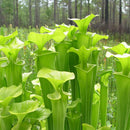Description
By Robin Mackie
Sarracenia flava is one of our tallest pitcher plants, a member of the genus Sarracenia, which contains 8 to 11 species of North American pitcher plants. Named after D.Sarrazin, a 17th century botanist of Quebec, most species in the genus (with the exception of Sarracenia purpurea) occur only in the southeastern United States. They have simple nodding flowers and leaves modified as hollow pitchers, which function to passively trap insects, luring them with nectar, then digesting them or drowning them with fluids, later to be absorbed by the plant.
The habitat of trapping insects in modified leaves or trumpets is thought to have been developed in response to the nutrient-poor soil conditions of wet or frequently flooded areas typical of the Atlantic Coastal Plain. This method of trapping is "passive" in that the plant does not close to eat its prey. Insect prey are lured into the slippery waxy portion of the upper pitcher tube by nectar, then slide down a coating of ultra-fine, downward point hairs, hitting the digestive enzymes, and into a zone which readily absorbs nutrients with digestive fluids. Although amphibians often use the pitchers as refugia, the paralyzing agent coniine has been isolated in S.flava fluids.
Easily distinguished from other pitcher plants by their tall, upright, yellow green or sometime red-veined pitchers (up to 3 foot tall), trumpet pitchers have large, broadly reniform hoods which lack white patches (windows), and arch widely over the column. The narrow base of the hood has sides that roll back until nearly touching, and often exhibit a maroon spot on the inside of the column. Large yellow, 5-parted flowers appear from April to May, have an unpleasant 'cat-pee' like odor, and are held singly on long stems above the pitchers to avoid trapping of potential pollinators. The fruit forms in 5 lobes and takes 5 months to mature, splitting to scatter 300-600 seeds which are 1.5-2mm in length, and have a rough, waxy coat for dispersal by water. New Sarracenia plants usually germinate in spring and immediately begin building tiny pitchers, which in subsequent years become larger as the plant grows. They eat bugs all summer long until the pitchers die back in fall, translocating nutrients from the pitchers to the underground rhizomes.
Description from: USDA/Forest Service
Photo by: Ricky Wrenn
Payment & Security
Your payment information is processed securely. We do not store credit card details nor have access to your credit card information.


